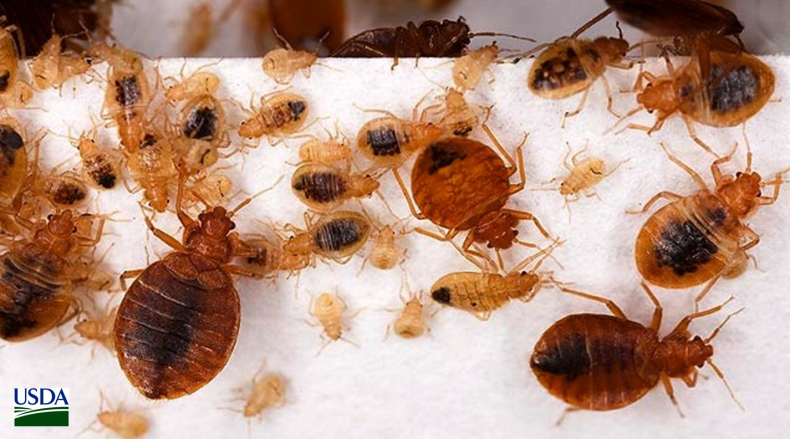|
It can be a lonely world for a bed bug researcher! Dr. Mark Feldlaufer began his presentation by extending an open invitation to visit his bed bug research lab at the United States Department of Agriculture-Agricultural Research Center in Beltsville, Maryland. He assured us that the offer rarely gets takers, and it is really not surprising, all things considered. As parasites that feed on people and cause itchy welts, bed bugs give people the heebie-jeebies. Just a picture or two of the bed bugs (Fig. 1) was enough to have several attendees visibly cringe, as they imagine the marks and persistent itches that usually follow after bed bug bites. However, Dr. Feldlaufer’s fascinating research, which aims to improve bed bug detection and control, may contribute to a future where everyone can rest assured that there truly are no creatures lurking under the bed.
often do not come in contact with them. It is impractical, dangerous, and against labelled usage, to coat every surface and crack of a home or business in insecticide, so bed bug chemical treatments often fail. The silver bullet control method appears to be heat treatments, but, like silver, heat treatments are expensive. Homes are heated to between 120-140⁰F for several hours to kill all bed bug life stages, which tend to cost anywhere between $2,500-$7,000. Though bed bugs themselves do not discriminate against the rich or poor, our methods of remediation tend to do just that. The most effective way to get rid of bed bugs is unaffordable to many.
In the course of his bed bug research, Dr. Feldlaufer has worked on other projects to help to detect and control bed bugs early in their infestations with a number of students, including our very own Dr. Kevin Ulrich. The team found that bed bugs consistently avoided a common chemical insect repellent, DEET, the main ingredient in most mosquito repellents. They did not, however, respond with greater avoidance to higher dosage. Although this may seem like a quick and easy fix, wearing DEET to bed may just cause bed bugs to merely move on to other surfaces (e.g. the couch). On the other hand, they also found that aldehyde compounds produced by bed bugs elicit a strong attractive response to other adult and immature bed bugs. These aldehydes may be one way bed bugs attract each other to form aggregations (Ulrich et al. 2016), suggesting that the aldehydes may be used to develop an inexpensive and more discreet option to lure and trap bed bugs. Dr. Feldlaufer currently aims to develop and test reduced risk pesticides that show promise in killing bed bugs. Bed bugs can be a terribly menacing presence in anyone’s home, but thankfully Dr. Feldlaufer has dedicated much of his career to keeping us informed about these insects and their crafty activities. By pairing lures with reduced risk pesticides, Dr. Feldlaufer aims to develop options to safely, affordably, and discreetly ensure we can sleep tight assured that the bed bugs will not bite. References: Lit L., Schweitzer J.B., and Oberbauer A.M. 2011. Handler beliefs affect scent detection dog outcomes. Animal Cognition 14: 387. Pfiester M., Koehler P.G., and Pereira R.M. 2008. Ability of bed bug-detecting canines to locate live bed bugs and viable bed bug eggs. Journal of Economic Entomology 101(4):1389-96. Ulrich, K.R., Kramer, M. and Feldlaufer, M.F. 2016. Ability of bed bug (Hemiptera: Cimicidae) defensive secretions (E)-2-hexenal and (E)-2-octenal to attract adults of the common bed bug Cimex lectularius. Physiological Entomology 41: 103-110. Author Bio: Hanna Kahl is a master’s student at University of Maryland in Dr. Cerruti Hooks’ lab researching the effects of red clover living mulch on arthropod pests and pollinators. Samuel Ramsey is a PhD student at University of Maryland in Dr. Dennis vanEngelsdorp’s lab researching Varroa destructor. Comments are closed.
|
Categories
All
Archives
June 2024
|
Department of Entomology
University of Maryland
4112 Plant Sciences Building
College Park, MD 20742-4454
USA
Telephone: 301.405.3911
Fax: 301.314.9290
University of Maryland
4112 Plant Sciences Building
College Park, MD 20742-4454
USA
Telephone: 301.405.3911
Fax: 301.314.9290




 RSS Feed
RSS Feed




